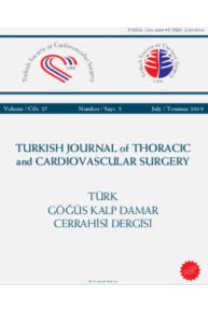Congenital coronary arteriovenous fistulas: An evaluation of 10 pediatric patients
Doğuştan koroner arteriyovenöz fistüller: 10 pediyatrik hastanın değe rlendirilmesi
___
- 1. Lee ML, Chen M. Diagnosis and management of congenital coronary arteriovenous fistula in the pediatric patients presenting congestive heart failure and myocardial ischemia. Yonsei Med J 2009;50:95-104.
- 2. Gowda RM, Vasavada BC, Khan IA. Coronary artery fistulas: clinical and therapeutic considerations. Int J Cardiol 2006;107:7-10.
- 3. Holzer R, Johnson R, Ciotti G, Pozzi M, Kitchiner D. Review of an institutional experience of coronary arterial fistulas in childhood set in context of review of the literature. Cardiol Young 2004;14:380-5.
- 4. Levin DC, Fellows KE, Abrams HL. Hemodynamically significant primary anomalies of the coronary arteries. Angiographic aspects. Circulation 1978;58:25-34.
- 5. Sunder KR, Balakrishnan KG, Tharakan JA, Titus T, Pillai VR, Francis B, et al. Coronary artery fistula in children and adults: a review of 25 cases with long-term observations. Int J Cardiol 1997;58:47-53.
- 6. Ibrahim MF, Sayed S, Elasfar A, Sallam A, Fadl M, Al Baradai A. Coronary fistula between the left anterior descending coronary artery and the pulmonary artery: Two case reports. J Saudi Heart Assoc 2012;24:253-6.
- 7. Ropers D, Moshage W, Daniel WG, Jessl J, Gottwik M, Achenbach S. Visualization of coronary artery anomalies and their anatomic course by contrast-enhanced electron beam tomography and three-dimensional reconstruction. Am J Cardiol 2001;87:193-7.
- 8. Karagöz T, Ozkutlu S, Celiker A. Percutaneous closure of a prenatally diagnosed large coronary artery fistula with an Amplatzer vascular plug immediately after delivery. Acta Cardiol 2008;63:405-8.
- 9. Karagöz T, Yıldırım I, Celiker A. Transcatheter closure of coronary artery fistula with an Amplatzer Duct Occluder II in a symptomatic infant. Anadolu Kardiyol Derg 2011;11:274-5.
- 10. Latson LA. Coronary artery fistulas: how to manage them. Catheter Cardiovasc Interv 2007;70:110-6.
- 11. Kassaian SE, Alidoosti M, Sadeghian H, Dehkordi MR. Transcatheter closure of a coronary fistula with an Amplatzer vascular plug: should a retrograde approach be standard? Tex Heart Inst J 2008;35:58-61.
- 12. Aydogan U. Transcatheter embolization treatment of coronary arteriovenous fistulas. Asian Cardiovasc Thorac Ann 2003;11:63-7.
- 13. Liberthson RR, Sagar K, Berkoben JP, Weintraub RM, Levine FH. Congenital coronary arteriovenous fistula. Report of 13 patients, review of the literature and delineation of management. Circulation 1979;59:849-54.
- 14. Sağlam H, Koçoğullari CU, Kaya E, Emmiler M. Congenital coronary artery fistula as a cause of angina pectoris. Turk Kardiyol Dern Ars 2008;36:552-4.
- 15. Ata Y, Turk T, Bicer M, Yalcin M, Ata F, Yavuz S. Coronary arteriovenous fistulas in the adults: natural history and management strategies. J Cardiothorac Surg 2009;4:62.
- 16. Wang S, Wu Q, Hu S, Xu J, Sun L, Song Y, et al. Surgical treatment of 52 patients with congenital coronary artery fistulas. Chin Med J (Engl) 2001;114:752-5.
- 17. Liang CD, Ko SF, Huang CF, Huang SC. Echocardiographic evaluation of coronary artery fistula in pediatric patients. Pediatr Cardiol 2005;26:745-50.
- 18. Schleich JM, Rey C, Gewillig M, Bozio A. Spontaneous closure of congenital coronary artery fistulas. Heart 2001;85:6.
- 19. Yilmazer MM, Demir F, Yolbaş I, Bilici M. Spontaneous closure of a symptomatic coronary artery fistula just within a few days of newborn period. Congenit Heart Dis 2014;9:27-30.
- ISSN: 1301-5680
- Yayın Aralığı: 4
- Başlangıç: 1991
- Yayıncı: Bayçınar Tıbbi Yayıncılık
Tüp torakostomiye bağlı eş zamanlı gelişen karaciğer, kalp ve damar yaralanması
Aslı Gül AKGÜL, Sadan YAVUZ, Ersan ÖZBUDAK, Ali AYDIN, Salih TOPCU
Two unusual causes of a rare clinical entity: Pneumomediastinum
Recep Oktay PEKER, İlhan PAŞAOĞLU, Haldun Onuralp KAMBUROĞLU, Timuçin SABUNCU, Şafak ALPAT
Fevzi TORAMAN, Ali BUTURAK, Murat ÖKTEN, Cem ARITÜRK, Selçuk GÖRMEZ, Şahin ŞENAY, Ümit GÜLLLÜ, Hasan KARABULUT, Cem ALHAN
Utku Arman ÖRÜN, Şeyma KAYALI, Mehmet Emre ARI, Selmin KARADEMİR, Vehbi DOĞAN, Özben CEYLAN, Senem ÖZGÜR, Mahmut KESKİN
Nadir disfaji nedeni olarak servikal vertebral osteofit: Üç olgu sunumu
Tülin YETİM DURGUN, Nilgün ÜSTÜN, Ayşen ŞENGÜL TASLAK, Yasemin KARABACAK BİLGİN, Hanifi BAYAROĞULARI
Mert DUMANTEPE, Osman FAZLIOĞULLARI, Süha KÜÇÜKAKSU, İbrahim UYAR, Mustafa SEREN
Selen ÖZTÜRK, İbrahim ÖZTÜRK, Seher İLHAN
Merih BALCI KALAMANOĞLU, Huriye Berk TAKIR, Cüneyt SALTÜRK, İrfan YALÇINKAYA, Zuhal KARAKURT, Cemal Asım KUTLU, Levent ALPAY, Özlem MOÇİN YAZICIOĞLU, Deniz GÜRER, Erdal TAŞÇI, Feyza KARGIN
Koroner revaskülarizasyon ile eş zamanlı asendan aortobifemoral baypas cerrahisi
Ufuk ALPAGUT, Mehmet BARBUROĞLU, Ömer Ali SAYIN, Onur Selçuk GÖKSEL, Murat UĞURLUCAN, Murat BAŞARAN, Nijat ALİSHEV, Didem Melis ÖZTAŞ, Enver DAYIOĞLU
Torakoskopik lobektominin gün geçtikçe artan önemi ve deneyimlerin paylaşılması
